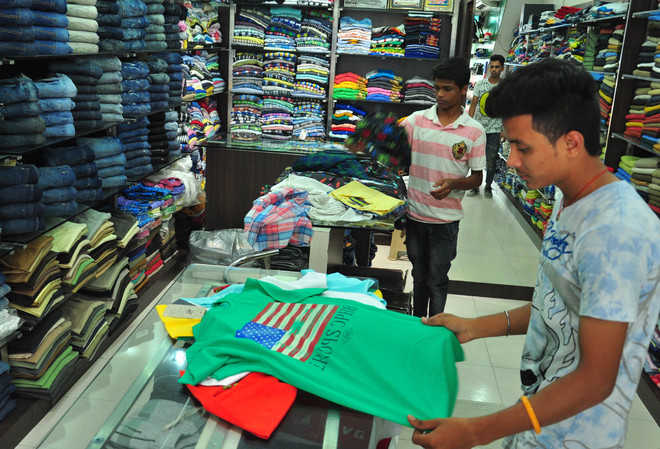Nikhila Pant Dhawan
Tribune News Service
Bathinda, May 27
Fond of wearing branded clothing but don’t have the heart to let company outlets burn a hole in your pocket? If you fall in the category of being on a shoestring budget while you go shopping but can’t keep your heart off the branded merchandise, then shops selling “branded export surplus” are where you should be heading to.
Over the past one year, a large number of retail outlets selling branded garments at factory price, in other words selling branded garments export surplus, have mushroomed in the city. A walk down the Mall Road, Bhagu Road, Bathinda-Goniana Road offers at least 15 such outlets.
Explaining the phenomenon, Amritpal Singh, owner of one such outlet on Mall Road, said, “Despite being a tier two city, Bathinda has a huge market for branded merchandise, especially garments. An increasing number of youngsters are gradually moving away from buying readymade garments from local market to buy branded garments from company outlets. A large part of brand conscious youngsters also want to save money and that’s when the export surplus comes in.”
“Export surplus shops not only offer branded clothing but also offer the same at a much lower price. So, one gets to wear branded garments and also gets to save,” Amritpal Singh said.
Owner of another such outlet on Bhagu Road added a word of caution for the customers. “In the hurry and happiness to buy branded clothing at cheaper price, the customers often don’t check the tags or holograms on the clothing items properly. Some shops also indulge in the malpractice of using fake brands and selling them as export surplus. One has to be wary of that,” he said.
What are surplus garments?
In broader terms, garments which are manufactured for the purpose of export but are either left out of the shipment or are rejected during inspection constitute the surplus garment segment. Usually, factories manufacturing branded clothing manufacture around five per cent more than the quantity required to complete the export shipment. After a complete shipment is sent off, the remaining branded garments are left with the manufacturing companies who usually have the liberty to sell the same to retailers for the purpose of sale in the open markets.
Another part of export surplus, the fact usually kept from the customers, comprises of garments which are rejected during strict quality control checks conducted by the companies before lifting the shipments from the factories. The reasons for rejection may vary from difference in the lot size, slight difference in colour shades or slightest of other manufacturing defects. These defects, while caught during inspection by trained staff of companies, usually are so miniscule that they go unnoticed by customers in the open markets.
Garments constituting cancelled shipments also flood the open markets. Again, the reason for cancelled shipment may be delay in the delivery of the shipment. It may also be cancelled even if the specifications of the garments miss the specifications given by the company by a whisker.
A win-win situation
Opening the doors of open-retail markets to the sale of export surplus has landed several players in a win-win situation. The manufacturing units, left with surplus garments have now been given a free hand by several companies to use the company tags and sell the same to the retailers. Instead of sitting over huge mounds of stock, the companies now immediately supply the same at manufacturing cost to cut down their own loss.
The retailers, meanwhile, have the advantage of selling these branded garments at “factory outlet rates”, which are usually lower, in some cases a lot lower than the rate at which the company is selling similar garments in their outlets. Offering “branded export surplus” lures the customers to these shops. This also saves the retailers from going through the grind of applying for a company franchise to sell branded items.
The customers also get to lay their hands on branded clothing items at discounted items without having to burn a hole in their pockets.
What’s the problem?
One may ask that if everyone is benefited by the sale and purchase of export surplus, what is the problem with the entire demand-supply chain? The main problem of export surplus garments is the fact that in cases of genuine export surplus, the customers usually face problem of getting a size that suits their body type.
Since a lot of these garments reach the markets after being rejected during quality control checks, most of these garments have no accurate size or colour ratio. In simpler terms, if the customers were to compare the size and colour of a garment bought from a company outlet with a similar garment at the export surplus house, the two would not match accurately.
Another major problem which also goes unchecked by authorities as well as customers in case of export surplus is the fact that increasingly, several retailers have started resorting to using fake tags on clothes manufactured locally and selling them in the name of branded export surplus. The slightest of change in the company logo or hologram gives them the leeway of making extra money.
Unlock Exclusive Insights with The Tribune Premium
Take your experience further with Premium access.
Thought-provoking Opinions, Expert Analysis, In-depth Insights and other Member Only Benefits
Already a Member? Sign In Now










